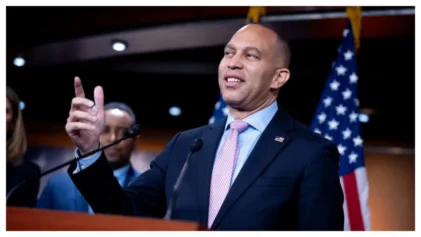
Donald Trump (Gage Skidmore)
Trump espouses no political ideology. Not only is he not a true conservative, but he has also self-identified as a Democrat as recently as 2015. He talks of job creation but is a proponent of no economic theory to create or sustain job growth. And he has no foreign policy experience whatsoever.
Yet, during the election, Trump supporters saw in him something they desperately craved and they described it using terms like “shake things up,” “anti-elitist” and especially “outsider.” While these terms say nothing about political ideology, they speak volumes about democratic norms.
Norms are the unstated rules of behavior by which we tacitly agree to abide. It is because of norms that we say “thank you” when someone holds a door for us; that we let riders off the train before boarding; that no matter how long the line at the theater, we obediently make our way to the end and wait to buy our movie tickets. No laws demand these things of us. We take these actions willingly without even considering alternatives. We do these things because they feel right.
Norms are not taught so much as they are absorbed through a process of critical observation. The behaviors of negative role models we reject; the behaviors of positive role models we internalize until their behaviors work their way into the fiber of the personal values we hold sacred. Norms shape who we are, embody our beliefs and form the core of what we stand for.
Laws are codified and policed. Norms are the essence of our shared values and enforce themselves.
This is not to say that laws and norms cannot work hand in hand. The laws governing the public behavior of political candidates, for example, are deliberately limited and permissive to encourage full-and-fair political discourse. Where the law is silent, however, democratic norms fill in.
There are no laws mandating that a political candidate be truthful; that he not threaten political adversaries; that he not use his pulpit to incite violence; that he respect the press and encourage them to report fairly and based on fact. Laws governing such behavior are unnecessary because the democratic norms by which political figures tacitly agree to abide mandate decorum, respect and, above all else, reverence for the democratic process. Such was the case until the 2016 presidential election.
As soon as Trump declared his candidacy, he exhibited a childish joy in the flagrant and public flouting of democratic norms. He repeatedly leveled personal attacks against his political foes and their families, openly threatening them with political retaliation and even imprisonment. He encouraged physical assault at campaign events. He incessantly lied to the press and was harshly dismissive of reporting he did not like, often limiting access to the news outlets that fell out of his favor. Yet, each normative breach seemed to expand and solidify his voter base.
Trump may indeed be bereft of the democratic norms of his predecessors. However, his candidacy would not have been fathomable were it not for the widespread normative decay around the turn of the century that resulted in the unraveling of the American Dream.
In 1996, an energy company by the name of Enron was awarded Fortune magazine’s “America’s Most Innovative Company.” That was the first of six consecutive years that Enron would earn the accolade, during which time the company’s value increased from $13.3 billion to well over $100 billion.
Enron was the poster child of capitalism, an economic system so robust that it could make select individuals very rich and still generously provide for the rest of us.
Enron was both proof and facilitator of the American Dream. As a bastion of corporate success, thousands of investment bankers and fund managers, and, by extension, tens of thousands of ordinary working people, bet on Enron as their key to a comfortable retirement — that final chapter of the American Dream entitled “The Good Life.”
The corporate norms of publicly traded companies dictated a symbiotic relationship between C-suites and their investors: The C-suite would ensure honest and accurate financial reporting and, in exchange, investors would reward successful C-suites with investment dollars. Sure, the C-suite got ultra rich, but a certain level of monetary inequity was palatable given the egalitarian nature of the stock market and a level playing field. Unbeknownst to everyone, including the SEC, the playing field was not level; normative erosion had torn through the Enron leadership so completely that it conspired to perpetrate corporate fraud of an unprecedented scale.
Enron had manipulated their books to mask massive debt. As the truth emerged, Enron was forced into bankruptcy in 2001, costing investors $74 billion, the largest bankruptcy in history at the time. Shareholders, fund mangers and their clients, and thousands of Enron employees whose pensions and savings were 100 in percent vested in Enron stock, lost everything.
In 2002, again following the discovery of fraudulent financial reporting, the telecommunications conglomerate WorldCom filed for bankruptcy, this time costing investors $180 billion and displacing Enron as the largest bankruptcy in history. Later that year, Tyco, a multibillion-dollar securities firm, filed for bankruptcy following the discovery of corporate fraud. Then, in 2003, it was HealthSouth and Freddie Mac. In 2005, it was AIG. In 2008, it was Lehman Brothers and Bernie L. Madoff Investment Securities. The details of each case were different, yet each case was the same: C-Suite normative decay leading to corporate fraud, resulting in multibillion-dollar bankruptcies, the brunt of which was born by shareholders, fund mangers and their clients.
There also was a heavy social consequence to these titanic bankruptcies. Following WWII, the stock market was regarded as the gateway to retirement. This pattern of corporate deceit forced America to contend with the reality that the stock market was not an egalitarian money engine for the masses. It was a system prone to the selfish manipulation of a few at the expense of the many. Absent the stock, most people were left with no safe means of funding their retirements beyond low-interest savings accounts and fledgling, tax-deferred retirement plans (many of which lost money during this period of time). The ideal of comfortable retirement had been reduced to an unattainable goal; a telling indicator regarding the declining health of the American Dream.
The mega bankruptcies of the 2000s dealt an additional blow to white America. While people of color have long been victims of institutional racism, much of white America generally is afforded a level of protection and privilege. The white executives who rigged the stock market, however, victimized everyone irrespective of race, color or creed. Being white in and of itself afforded you no protection: You had to be both white and rich. “White entitlement” had been recast as “elite-white entitlement.” (This was the root of the class-based fissure in both the white community and the Republican Party that Trump so brilliantly exploited with his anti-elitist rhetoric.)
As the blue-chip titans of the stock market began to fall over one another, a crisis in the banking industry was turning home ownership into yet another unattainable ideal of the fading American Dream.
In the late 2000s, banks began targeting lower-income families and individuals with “affordable mortgages.” Because many of those targeted were high-risk borrowers with a high likelihood of default, the practice came to be known as “predatory lending.”
While these loans made home ownership affordable to people who might not otherwise have been able to afford it, the introduction of these loans also created a glut of home buyers resulting in an artificial spike in home values. When the housing market corrected itself, most of these new homeowners were left with property worth much less than they paid, financed by sub-prime, adjustable-rate mortgages. As mortgage rates trended upwards, defaults reached epidemic levels. Predatory lending disproportionately affected Blacks and Hispanics, but it caused sufficient damage across the general population that, like retirement, home ownership seemed beyond reach. By the end of the decade, the American Dream was dead.
The second Obama administration coincided with a turning point in the demographics of the U.S. The aggregated birth rate of people of color in the U.S. exceeded that of whites. Half of the country celebrated its newfound ownership of an increasingly diverse America. The other half lamented the loss of “their” country to minorities, foreigners and the white elite. For this cohort, the white, disenfranchised, victims of normative decay, the New American Dream was to turn back the clock of social evolution, to “shake things up” and take “their” country back —to make America great again.
Enter Donald Trump, a first-time public servant incapable of articulating a coherent argument about anything. His system of norms is mutually exclusive with democratic social norms. Trump’s normative system, however, is very much in keeping with the social norms of a different form of government: apartheid.
This is precisely the type of “outsider” Trump supporters coveted: not a political outsider but rather a normative outsider who would eschew demographic trends and sociocultural enlightenment by creating an apartheid government to deliver a new American Dream to the white Christian masses.
—————————————————————————————————
Michael Maliner is a mixed-race writer who writes about race, culture, and identity. You can follow him on Twitter @PlasticSpoon, and he can be reached at michaelmaliner.com


